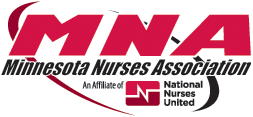FOR IMMEDIATE RELEASE
Contact: Shannon Cunningham
651-269-1418
Shannon.Cunningham@mnnurses.org
St. Paul, MN (June 25, 2025) — The Minnesota Department of Health (MDH) has just released its 2024 Adverse Health Events Report, showing the ninth straight year of increases in preventable patient harm across Minnesota hospitals and surgery centers. Nurses across Minnesota say this report is not just a statistic, it’s a wake-up call.
In 2024 alone, there were 624 adverse events, which includes preventable errors like patient falls, pressure ulcers, wrong-site procedures, and communication breakdowns. These incidents are not just mistakes. They’re symptoms of a deeper, ongoing problem: unsafe staffing levels.
Recent trends have seen an increasing number of hospitals relying on private consulting firms to identify the easiest areas to cut costs. Unfortunately, this has lead to hospitals choosing to cut the easiest cost source: the humans who provide actual care for patients. Nurse researcher Linda Aiken has repeatedly found that for each additional patient a nurse has to care for, the mortality rate, length of stay, readmission rate, and risk for adverse events increase as much as 16%.
“Hospitals can ignore nurses, but they can’t ignore the data,” said MNA President Chris Rubesch, RN. “Nurses have been warning about this for years. When hospitals undercut staffing levels, both patients and staff suffer the consequences.” The MDH report cites increased patient complexity and length of stay, but it also points to the clear workforce challenges that hospitals refuse to solve. Persistent issues tied to staffing continue to rise. Medication errors declined in 2024, but nearly every other category of preventable harm went up. A growing body of evidence proves that the solution to an increase in adverse events is simple. Increased nurses at the bedside.
“We recognize healthcare is complex, but this isn’t: we need more nurses at the bedside,” said Rubesch. “And up until this point in our 2025 bargaining talks, not a single hospital in Minnesota has responded to our safe staffing proposals.”
In response to stalled negotiations, Unfair Labor Practice violations and the refusal of hospital executives to agree to enforceable staffing standards, all MNA chapters statewide have voted to authorize a strike. Nurses are demanding safe staffing in their 2025 contracts—not as a symbolic gesture, but as a life-saving necessity.
Safe staffing is the solution. Four reasons to fix it now.
- More nurses at the bedside = More lives saved. Research and experience show that safe staffing levels reduce complications and save lives. That’s not just data, it’s common sense. Nurses want to prevent, not just respond to, adverse events.
- Hospitals are losing good nurses. When staffing is unsafe, experienced nurses leave. The system becomes even weaker. Nurses are not quitting the profession, they’re quitting unsupportive conditions and leaving for different clinical settings. Multiple studies even show that a main contributor to nurses leaving the bedside is burn out. The highest contributor of burn out: Inadequate staffing.
- Preventing harm is cheaper than paying for it. Falls, pressure ulcers, and hospital-acquired infections cost far more than fair staffing. Each adverse event comes with a cost: human and financial. Safer care means fewer lawsuits, shorter stays, and fewer readmissions. This is further backed by studies that show the cost of additional labor is less than the cost of repeated adverse events.
- Safer workplaces. Understaffed units are dangerous and lead to more injuries. Nurses are managing more aggressive patients and more violent incidents than ever before, often without security or support.
What this means for negotiations
Minnesota nurses are participating in contract negotiations with one clear ask: stop the harm before it happens. This report makes the urgency undeniable. Data confirms what nurses have seen and felt for years: fewer nurses means worse patient outcomes.
“Nurses are ready to work with hospitals to fix this,” said Rubesch. “If executives won’t act on our words, they’ll have to act on the facts.”


